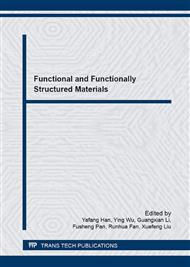p.64
p.72
p.77
p.82
p.89
p.94
p.99
p.111
p.120
Preparation and Properties of Recycled PET Fibers Filled Polyethylene Composites
Abstract:
Responding to the resource waste and environmental damage, the recycled Polyethylene Terephthalate (PET) fibers were successfully obtained from waste PET textiles using a PFI mill. The high density polyethylene (HDPE)-based composites reinforced with recycled PET fibers were manufactured by melting blend. The mechanical properties of the composites were investigated by mechanical property test. The thermal stability and crystallinity were analyzed by Thermogravimetric Analysis (TGA) and Differential Scanning Calorimetry (DSC), and their microstructures were characterized by Scanning Electron Microscopy (SEM). The mechanical properties of the composites indicated the significant improvements in tensile, flexural and impact properties by increasing the recycled PET fibers to 20wt%. The morphological and structural results showed that the recycled PET fibers dispersed well in HDPE matrix with the help of PE-g-MAH as a compatibilizer. The thermal analysis revealed that the degree of crystallinity and crystallizing rate tended to increase, while the thermal stability remained stable. In addition, using PFI mill in dealing with the waste textiles will help open new ways for recycling of waste textiles.
Info:
Periodical:
Pages:
89-93
Citation:
Online since:
March 2016
Authors:
Keywords:
Price:
Сopyright:
© 2016 Trans Tech Publications Ltd. All Rights Reserved
Share:
Citation:


